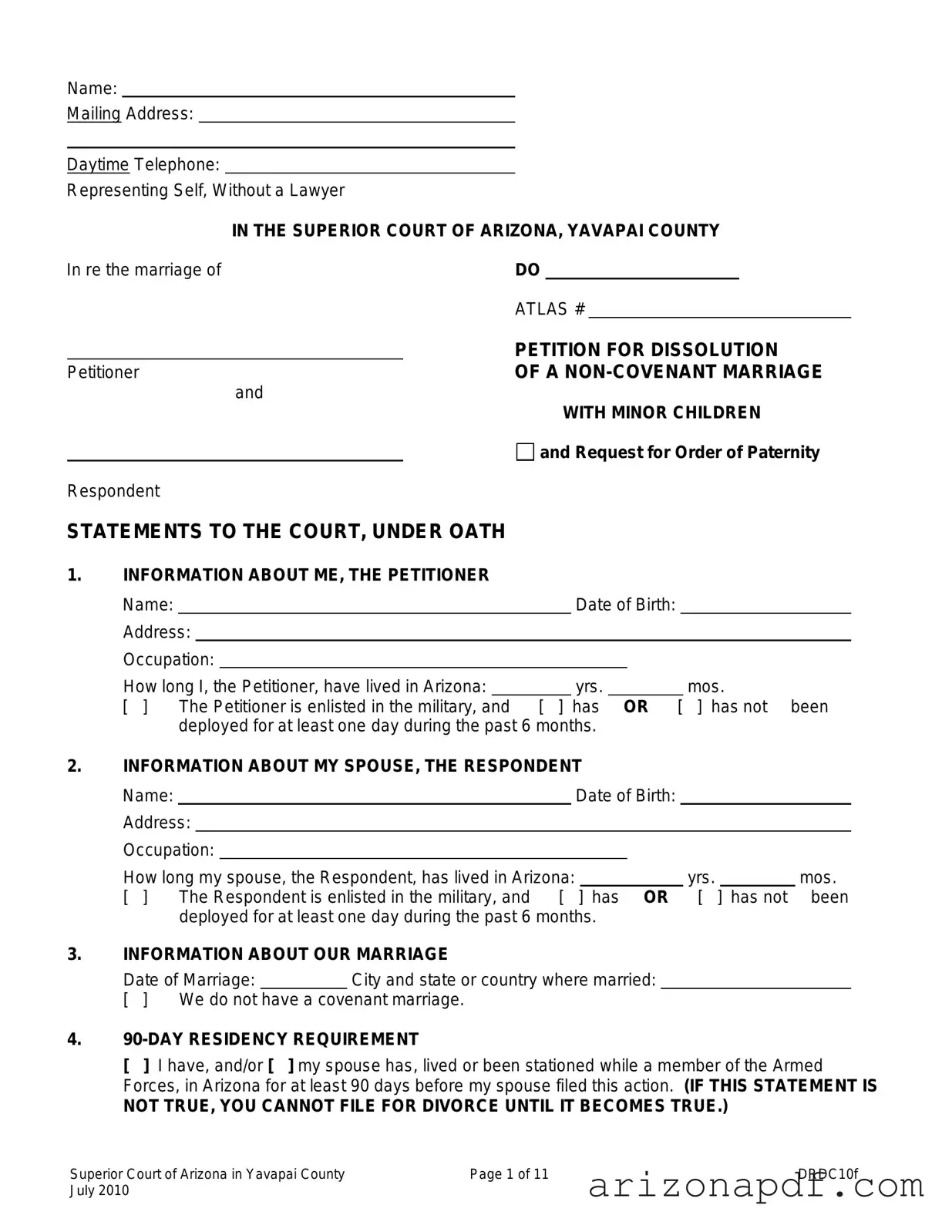The Arizona DRDC10F form, specifically designed for petitioning the dissolution of a non-covenant marriage with minor children, shares similarities with other legal documents related to family law and divorce proceedings across various jurisdictions. For example, the "Petition for Dissolution of Marriage" form used in other states like California or New York closely resembles the DRDC10F form. These petitions include personal information about the spouses, details about the marriage, residency requirements, and stipulations regarding division of assets, debts, and child custody. This similarity demonstrates how family law consistently requires detailed information to process divorce proceedings adequately.
Another document that bears resemblance to the Arizona DRDC10F form is the "Financial Affidavit" commonly used in divorce cases. This affidavit requires both parties to disclose their financial status comprehensively, including income, expenses, assets, and debts. Although serving a different specific purpose, its collection of detailed financial data parallels the property and debt sections of the DRDC10F form, emphasizing the importance of financial transparency in divorce cases.
The "Child Custody Agreement" document also shows similarity to the DRDC10F form, especially in sections concerning children from the dissolving marriage. Both documents address the need for detailed plans regarding the care, custody, and support of minor children. This includes living arrangements and future parental responsibilities. The focus on children's welfare in both documents underscores the legal system's prioritization of children's best interests in divorce cases.
The "Petition for Legal Separation" is another similar document, often filed when couples are contemplating separation without an immediate divorce. Like the DRDC10F form, it includes sections on property, debts, and children but does not lead to the dissolution of the marriage. The resemblance lies in the comprehensive outline of the couple's shared responsibilities and assets, aiming to arrange matters legally even if the marriage is not being dissolved.
A "Petition for Annulment" shares fundamental similarities with the DRDC10F form as well, particularly in the sections that outline personal details of the spouses and the nature of their relationship. Both documents serve to legally alter marital status but under different conditions, with an annulment treating the marriage as though it never legally existed. The inclusion of personal and marriage details is vital to both documents for establishing the legal grounds for their respective proceedings.
The "Request for Order" form, often used in family law to request court orders related to custody, support, or property division, parallels the DRDC10F form's sections that petition for specific outcomes, like custody arrangements or division of assets. This document shares the mechanism of formally requesting legal determinations based on outlined circumstances and desired outcomes, albeit more broadly across family law matters beyond just divorce.
"Pretrial Statements" in divorce cases, required in some jurisdictions before trial, share the comprehensive nature of the DRDC10F form in requiring detailed disclosure of each party's position on matters like assets, debts, and child custody. These statements facilitate an organized trial process by preemptively presenting the information to the court, similar to how the DRDC10F form organizes and presents the needs and wants of the petitioning party.
The "Separation Agreement" document, though not always a court form, often outlines the mutual understanding between spouses regarding the division of assets, debts, child support, and custody. Its resemblance to the DRDC10F form lies in its detailed approach to resolving marital issues amicably, aiming to avoid further disputes. This agreement can cover much of the same ground as the DRDC10F, albeit typically as a mutual contract rather than a court petition.
The "Marital Settlement Agreement" closely aligns with the Arizona DRDC10F form by detailing how divorcing spouses have agreed to settle matters of property, debt, spousal support, and child custody. This agreement is often part of finalizing a divorce and can resemble the DRDC10F form in its comprehensive coverage of every aspect of the marriage dissolution, tailored towards ensuring a fair and clear division and responsibilities.
Lastly, the "Child Support Order" documents, while specifically focusing on financial support for children, share the DRDC10F form's attention to children's welfare in divorce proceedings. They outline financial responsibilities towards minor children but within the broader scope of ensuring children's needs are met post-divorce, demonstrating the legal system's focus on child welfare within family law disputes.








